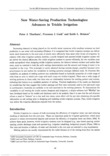New Water Saving Production Technologies: Advances in Trickle Irrigation
JIRCAS international symposium series
| ISSN | 13406108 |
|---|---|
| 書誌レコードID(総合目録DB) | AA1100908X |

本文フルテキスト
intlsymp-10_53-62.pdf383.6 KB
Increasing demand is being placed on the world's water resources with resultant pressure on food production to use water with increasing efficiency. It is recognized that trickle irrigation systems can deliver water (and chemicals) to the root zone of plants more efficiently than most other forms of irrigation. In common with other irrigation systems, however, a poorly designed and operated trickle irrigation system will not deliver the desired efficiencies. For trickle irrigation systems to operate efficiently, the two variables most easily manipulated when designing trickle irrigation systems, the distance between emitters and emitter flow rates, must be matched, to both the soil's wetting characteristics and the amount and timing of water to be supplied to the crop. This principle is rarely adopted during system design, possibly because most practitioners do not realize the variability in wetting patterns amongst different soils. To illustrate this variability, an analysis of wetting patterns was undertaken based on hydraulic properties of a wide range of soils from an area in which row crops and small crops are trickle-irrigated. There was a wide range of wetting patterns in these soils, but there was no relationship between the wetting pattern and texture, indicating that texture is an unreliable predictor of wetting. Practical implications of the results are illustrated by considering that they suggest that emitter spacings and flow rates commonly used in row and small crops in northeastern Australia are unlikely to be well matched to the wetting patterns. To demonstrate the variability in soil wetting for trickle system designers and irrigators, a simple software tool "WetUp" has been developed based on the models and databases used in the analysis. Once it is seen that the soil structure allows a sand to "behave" as a clay and vice versa, more effort will be put into obtaining site-specific information on soil wetting prior to designing and installing trickle irrigation systems. Then, trickle irrigation may deliver the irrigation efficiencies expected from the system.
| 作成者 | Peter J. Thorburn Freeman J. Cook Keith L. Bristow |
|---|---|
| 公開者 | Japan International Research Center for Agricultural Sciences |
| オンライン掲載日 | |
| 号 | 10 |
| 開始ページ | 53 |
| 終了ページ | 62 |
| 言語 | eng |
